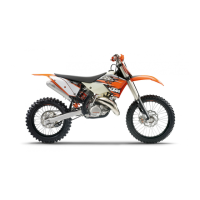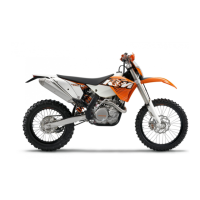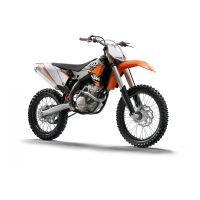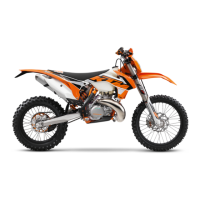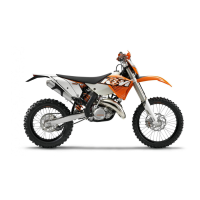Do you have a question about the KTM 300 EXC EU 2010 and is the answer not in the manual?
Explains symbols used in the manual.
Explains typographical and other formats used.
Defines intended use for EXC/XC-W models regarding road and off-road use.
Stresses importance of maintenance, warranty conditions, and spare parts.
Guidelines on repairs, transport safety, and general warnings.
Discusses environmental impact and defines risk levels (Danger, Warning, Note).
Emphasizes reading the manual for safe operation and maintenance.
Identifies key components from left front and right rear views.
Details locations of chassis, type, key, engine, and part numbers.
Explains clutch, brake, throttle, short circuit, light, and horn controls.
Details starter, emergency OFF, and short circuit buttons.
Covers turn signal switch and indicator lamps for EXC models.
Covers speedometer operation, activation, and trip master functions.
Explains various display modes like speed, service hours, clock, and odometer.
Details lap time, trip masters, average speed, and stopwatch operations.
Details fuel tap, filler cap, and choke operations.
Explains kickstarter, shift lever, side stand, and steering lock.
Covers foot brake lever and hand brake lever adjustments.
Provides initial use guidance and safety warnings for riders.
Covers engine break-in and preparation for varied terrain.
Details specific preparations for dry sand, wet sand, and muddy surfaces.
Outlines essential checks before operation and engine starting procedures.
Guides on shifting, riding, and proper braking methods.
Instructions for safe stopping, parking, and refueling.
Lists maintenance tasks for authorized workshops at different intervals.
Details essential checks and maintenance performed by the rider.
Covers jacking, work stand, chassis setting, fork/shock adjustments.
Details front/rear brake fluid, linings, and lever travel adjustments.
Covers throttle cable, chain, brake discs, wheel, and tire checks.
Covers battery, fuses, headlight, seat, fuel tank, and cooling system.
Details silencer and air filter servicing.
Guides on clutch, shift lever, and carburetor adjustments/service.
Details gear oil level checks, changes, and other fluid checks.
Addresses common engine problems like starting, idle, power, and overheating.
Provides guidelines for washing and cleaning the motorcycle.
Instructions for preparing and storing the motorcycle.
Lists engine specs, capacities, and tightening torques for various models.
Details carburetor types, jets, and settings based on conditions.
Lists chassis, fork, and shock absorber technical data.
Lists torque values for chassis components and fasteners.
Provides electrical schematics for different model groups.
Lists specifications for fluids, oils, cleaners, and recommended products.
Explains relevant industry standards for oils and engine performance.
Explains symbols used in the manual.
Explains typographical and other formats used.
Defines intended use for EXC/XC-W models regarding road and off-road use.
Stresses importance of maintenance, warranty conditions, and spare parts.
Guidelines on repairs, transport safety, and general warnings.
Discusses environmental impact and defines risk levels (Danger, Warning, Note).
Emphasizes reading the manual for safe operation and maintenance.
Identifies key components from left front and right rear views.
Details locations of chassis, type, key, engine, and part numbers.
Explains clutch, brake, throttle, short circuit, light, and horn controls.
Details starter, emergency OFF, and short circuit buttons.
Covers turn signal switch and indicator lamps for EXC models.
Covers speedometer operation, activation, and trip master functions.
Explains various display modes like speed, service hours, clock, and odometer.
Details lap time, trip masters, average speed, and stopwatch operations.
Details fuel tap, filler cap, and choke operations.
Explains kickstarter, shift lever, side stand, and steering lock.
Covers foot brake lever and hand brake lever adjustments.
Provides initial use guidance and safety warnings for riders.
Covers engine break-in and preparation for varied terrain.
Details specific preparations for dry sand, wet sand, and muddy surfaces.
Outlines essential checks before operation and engine starting procedures.
Guides on shifting, riding, and proper braking methods.
Instructions for safe stopping, parking, and refueling.
Lists maintenance tasks for authorized workshops at different intervals.
Details essential checks and maintenance performed by the rider.
Covers jacking, work stand, chassis setting, fork/shock adjustments.
Details front/rear brake fluid, linings, and lever travel adjustments.
Covers throttle cable, chain, brake discs, wheel, and tire checks.
Covers battery, fuses, headlight, seat, fuel tank, and cooling system.
Details silencer and air filter servicing.
Guides on clutch, shift lever, and carburetor adjustments/service.
Details gear oil level checks, changes, and other fluid checks.
Addresses common engine problems like starting, idle, power, and overheating.
Provides guidelines for washing and cleaning the motorcycle.
Instructions for preparing and storing the motorcycle.
Lists engine specs, capacities, and tightening torques for various models.
Details carburetor types, jets, and settings based on conditions.
Lists chassis, fork, and shock absorber technical data.
Lists torque values for chassis components and fasteners.
Provides electrical schematics for different model groups.
Lists specifications for fluids, oils, cleaners, and recommended products.
Explains relevant industry standards for oils and engine performance.
| Displacement | 293.2 cc |
|---|---|
| Transmission | 6-speed |
| Front Tire | 90/90-21 |
| Rear Tire | 140/80-18 |
| Compression Ratio | 12.5:1 |
| Starter | Kick starter |
| Engine Type | Single cylinder, 2-stroke |
| Bore x Stroke | 72 mm x 72 mm |
| Seat Height | 960 mm |
| Fuel Tank Capacity | 9.5 L |
| Fuel System | Keihin PWK 36 S AG |
| Ignition | Kokusan |
| Frame | Central tube frame made of chrome molybdenum steel tubing |
| Front Suspension | WP 48 mm USD forks |
| Rear Suspension | WP PDS shock |
| Front Brake | 260 mm disc |
| Rear Brake | 220 mm disc |
| Wheelbase | 1485 mm |

